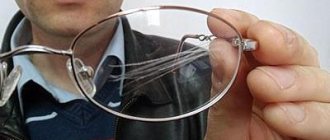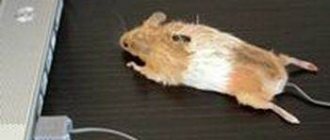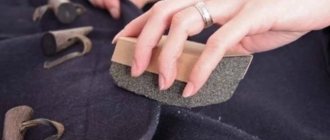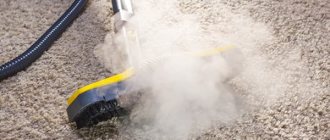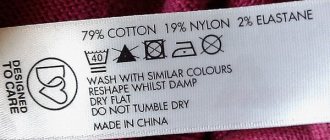What is microfiber made of?
The fabric consists of individual fibers from polyester or polyamide, processed into multifilament yarn. It is only twice as thick as cotton - about five microns. Fine-mesh and close pieces of fabric are woven from threads. Some napkins are made up of individual fibers joined together. They are of higher quality.
Sofia Ernst built an excellent career, but at its dawn she often quarreled with her husband
You don’t always need to be demanding: the child will start doing evil and not only
Leo and Libra: the most similar zodiac signs
Types of glasses for glasses
According to statistics, a quarter of all inhabitants of our planet wear glasses. This is why it is so important to know the features of glasses care. But before you understand the rules and methods of cleaning, it is worth knowing what they can be made of, since the features of use and maintenance largely depend on the material of manufacture.
What can eyeglass lenses be made of?
- Glass. Their main advantage is that they are durable, reliable, and also help with various pathologies of visual function in humans. They are durable, but it is important to properly and daily care for such an accessory. At the very least it needs to be wiped down. The disadvantages include fragility, since it is glass, quite heavy weight, and not a very aesthetically beautiful appearance. Although recently many models for vision correction have appeared that can become a fashion accessory.
In order to figure out which glasses lenses are best to choose, you should visit an ophthalmologist, and then choose from the available model range.
- Plastic. Glasses made of plastic are much cheaper than their glass counterparts. They are lighter and thinner, but the glass itself is easily susceptible to mechanical stress, since any scratch, even a minor one, can ruin the appearance of the accessory.
- Plastic with anti-reflective coating. These glasses have the same advantages and disadvantages as accessories made from regular soft plastic, but they require more careful care.
How to extend the life of your glasses
In order for corrective optics to serve for a long time and not cause discomfort during operation, you should not wipe off the resulting dirt with the edge of your clothing. Dirt on the fabric can scratch the lens, and the material may be too rough, especially if you're wiping plastic lenses this way.
Placing glasses on a table or bedside table is also strictly prohibited - such actions will quickly lead to scratches and the need to buy new glasses. Therefore, glasses should always be placed with the lenses up.
To keep your glasses always perfectly clean, without streaks or scratches, you just need to follow the above recommendations. Taking good care of corrective optics will not only extend its service life, but also make you feel comfortable under any circumstances.
Source
Methods for cleaning glasses
Anything can end up on the lenses. This includes dust, remnants of cream or skin flakes, fingerprints and much more. All this reduces the quality of a person’s vision, regardless of whether they are glasses for pathologies of visual function or a regular sun protection accessory.
It is important to systematically clean, since dirt tends to eat into scratches and cracks, if any, and then the quality of vision noticeably decreases.
The main methods for cleaning glasses include the following:
- Using special or professional care products. They are sold in special optical stores or pharmacies. They can be in the form of a spray or liquid, depending on the lens material. It is important that such professional products are free of alcohol and abrasive materials.
- Using napkins (soft or damp). Microfiber cloths are soft, remove dust, particles of grease and skin flakes well, and do not scratch the surface. This product is suitable for glass and plastic accessories. An analogue could be suede napkins. Wet wipes for glasses, which are impregnated with a special solution, are mainly intended for glasses. They not only remove dirt from the surface, but also prevent the growth of bacteria. If the composition contains antibacterial substances, they may leave streaks on the plastic surface. Therefore, before wiping your glasses with such products, you need to know the composition of the substance.
- Using household cleaning products. This could be soap, shampoo or dishwashing detergent that actively fights fat. The accessory is washed using these products under running water. Dirt is easily removed, but after that you need to let the glasses dry, preferably in a vertical position.
- Glasses prescription - where to get and correctly decipher the form
- Glasses for constant wear for myopia
- What are yellow glasses for? Why special yellow glasses for drivers?
- How to choose swimming goggles
Be careful, alcohol!
Perhaps everyone would have believed in the absolute safety of wet wipes for glasses if the topic had not interested the editors of Markt, the consumer magazine of the North German radio company (NDR), and they would not have commissioned specialists from the Ernst Abbe Hochschule Jena to conduct their examination of six different wet wipes manufacturers. During the examination, carried out under the leadership of Professor Stefan Degle, experts came to the conclusion that the alcohol included in most wet wipes for glasses can corrode some types of plastics. For example, polycarbonate is sensitive to the effects of alcohol, which, due to its high strength and resistance to impact loads, is widely used in the production of lenses for children's and sports glasses.
The alcohol contained in wet wipes can pose a threat not only to eyeglass lenses, but also to frames made, for example, from certain plastics and natural materials. Thus, the material TR-90, widely used in the production of sports glasses, breaks down under the influence of alcohol, and the surface layer of a number of other materials suffers. Theoretically, you can, of course, purchase napkins without alcohol. But only theoretically: as Markt magazine reports, the manufacturer is obliged to write on the packaging that the product contains alcohol only if its alcohol content is 20% or more. And only a few manufacturers indicate the complete absence of alcohol in their wipes. However, even alcohol-free wet wipes do not seem to be the best solution for caring for eyeglass lenses. “We know that the popular anionic surfactants to which the wipes owe their cleaning effect pose a threat to at least polycarbonate lenses, and therefore to most sunglasses. For this reason, by the way, wet wipes are not allowed to wipe windows on airplanes. From their use, scratches first appear, and then the top layer dissolves at the site of the scratch. Contact with sweat and cleaning products contributes to this,” says Britta Hoffmann of the German company Deutsche Augenoptik, a major supplier of vision correction products.
Source
Types of wipes for glasses
They are made of microfiber - fabric with thin fibers . By the way, this is where its name comes from – a derivative of the word “micro”. The basis is polyamide and polyester, which perfectly absorb moisture and fat.
According to their physical characteristics, they are soft, durable, elastic, quick-drying, wrinkle-resistant, and have a slightly velvety tactile sensation. And the ability to accumulate static electricity makes it possible to attract dust and lint very well. The cloth can be used both dry and wet.
Women's clothing in rustic style
How to Wear Sneakers with Skirts and Dresses and Look Stylish
Wet wipe – good or bad?
Despite all the efforts of manufacturers, none of them have yet succeeded in inventing self-cleaning spectacle lenses. This means that dust, dirt, secretions from sweat glands, and particles of exfoliated skin to a greater or lesser extent always settle on the surface of the lenses, thereby worsening their optical properties. To clean lenses, glasses users often use special wet wipes, which can be bought anywhere today. They traditionally contain water, flavor (usually citrus), anionic or nonionic surfactants, and alcohol. “The components contained in spectacle wipes do not cause any harm to spectacle lenses,” was the verdict issued in June 2022 by the Institute of Physical Chemistry of the Friedrich Schiller University of Jena*. In collaboration with RCP Ranstedt, which annually produces several billion eyeglass wipes for various companies, the institute's working group, led by Professor Dr. Helga Dunken, tested samples of commercially available wipes to determine their safety for eyeglass lenses - how mineral and organic. Despite the positive verdict, in 220 cases flaws were still found on the lenses during the study. The press release gave the following explanation for this: “In 85% of cases of damage**, they were caused by poor-quality coating of budget eyeglass lenses.” This meant that the scratches on the lenses appeared even before they were cleaned with wet wipes; in this case, any, even the most minimal thermal or mechanical impact may be enough to render the coating unusable.
How long can I use it afterwards?
The threads from which the napkin is made, due to their structure, have high strength and wear resistance. Therefore, they can withstand long-term use and repeated washing (up to 500 times!) . Undoubtedly, this is cost-effective. In addition, the cloth will not take up much space in your purse or pocket.
Regular use of this napkin will extend the life of your glasses, maintain the integrity of the lens coating and clarity of vision.
What should you not use?
There are always a lot of household products that seem to be able to be used to clean the surface of glasses. So, some people choose handkerchiefs, scraps of fabric, clothes as napkins for them, and ammonia or simple alcohol, vinegar and liquid for washing glass and mirrors as products.
Why is it not worth wiping lenses with them? Although fabric, clothing, and handkerchiefs may be soft to the touch, they can scratch the soft surface of the glasses. Microcracks may not be visible at first glance, but dirt will accumulate in them.
Alcohol or vinegar does not make glass cleaner, and can even harm plastic. Window cleaning liquid is an extreme option that can only be used in extremely rare cases due to the large number of destructive substances in its composition.
What kind of fabric is this and what is it afraid of?
Microfiber is woven from the finest fiber - polyester, polyamide or nylon. It is used to make bedding, towels, cleaning equipment, furniture, eyeglass wipes and car seats.
Synthetics do not tolerate hot water, ironing, bleaching and aggressive detergents. It is also not recommended to twist it too much when spinning, although the material is resistant to deformation. The fabric does not like the effects of fabric conditioner; because of it, it loses its unique properties.
For information: Due to improper care, microfiber does not tear or lose its properties instantly, but it wears out noticeably faster. If you wash the products correctly, they will last for several years.
Manufacturers usually indicate on the label how to care for the material, whether it can be machine washed or whether it is recommended to remove dirt manually. There is also information about temperature conditions.
Why wipe your glasses?
Eyeglasses are made from many materials; many people prefer glass and plastic models. Today, modern materials with protective coatings are used, which make lenses more resistant to scratches and other damage. Despite this, you need to take good care of your glasses. While wearing them, they get dust, dirt, particles of epidermis, and sweat. Stains remain on them and spots appear. Firstly, such glasses look unaesthetic, so it should be kept clean. Secondly, dirty glass affects the quality of correction. With such glasses, the image is not clear enough. Their eyes get tired and red. Asthenopia and other unpleasant ophthalmological symptoms develop. There is another important aspect. High-quality branded glasses are not cheap. Careful handling will allow you to avoid unnecessary expenses associated with replacing glasses and frames. Let's find out how you can wipe your glasses lenses and what products are used to care for them.
Anti-fog sprays for glasses
They are special liquids for cleaning optics, including glasses. These sprays contain components that ensure thorough cleaning of glass without streaks. Some liquids have antistatic, antifog and even disinfectant properties. Similar products are produced by (Good Look Antifog), Bentus Laboratories (Sanitelle). These sprays are used as follows: apply it to the entire surface of the glass and wipe gently with a special cloth. This will remove all contaminants. To protect your glasses from fogging, simply spray the lens spray and leave until completely dry.
Can glasses lenses be washed with regular soapy water?
If you have nothing to wipe your glasses with, that is, there are no napkins or sprays specially designed for this at hand, hot water and soap will come to your aid. First, rinse your lenses with warm water. Dissolve soap in water and apply the foam that forms on its surface to the glass. Rub them with your hands and rinse again with clean water. After drying, there should be no streaks on the lenses. During the care process, you can also clean the frame. Use cotton swabs for this. The “disadvantage” of this method of care is the impossibility of using it outside the home.
In the washing machine
If you don’t have the time or desire to soak and wash microfiber by hand, you can use an automatic machine.
The recommendations here are:
- Since the fabric is voluminous, the drum is ¾ loaded.
- Washing is done in a delicate cycle: too intense rotation damages the fibers.
- There is no need to put in too much powder, just fill the compartment as for a normal cycle.
- Wash microfiber cloths separately from other items, as lint and hair may collect on their surfaces.
- Temperature: 40-50 degrees.
- Do not wring out microfiber in the washing machine; it is better to remove moisture manually.
Important When choosing a microfiber washing powder, make sure that it does not contain bleaching particles or conditioner.
Benefits of microfiber cloths
- When using wipes made from this fabric, you will not need household cleaners.
- They remove dirt, both dry and wet, without leaving streaks.
- Dirt held by microfibers does not spread further over the surface. Therefore, napkins can be used several times before washing.
- Microfiber fabric is quite durable, retains its shape for a long time, and can be used to remove various contaminants in the home. In addition, it does not leave lint.
How to protect your glasses from dirt
In order not to think about how to clean your glasses in the future, you need to study certain recommendations that will help protect your glasses from further contamination:
- Glasses should only be stored in a special case.
- The case must be kept clean. When crumbs or dust first appear, you need to get rid of them.
- People who try to lead an active lifestyle must attach a chain or rope to their glasses.
- To remove or put on glasses, you only need to hold them by the ears.
- Be careful not to expose your glasses to harmful chemicals.
- It is not recommended to repair optics yourself. It is better to turn to real professionals in their field.
- To prevent windows from fogging up in the cold season, you should use special wipes and sprays.
- If the glass has scratches that cannot be repaired, then this can negatively affect your vision.
- Eyeglass lenses need to be replaced once or twice a year.
We suggest you familiarize yourself with How to wash curtains made from soft material. These are the basic tips that will help you get rid of the appearance of dirt on your glasses. Now it's time to find out what you shouldn't use to wipe your glasses.
Special care products for glasses
When purchasing glasses, you should definitely ask what products can be used to clean the selected model. Products intended for cleaning glasses can be purchased at specialized optical shops or pharmacies. Today, there is a considerable assortment of all kinds of cleansing products from different manufacturers on sale, so each person can easily select the product that is suitable for him.
Liquid products
Lens cleaning fluids are gentle, and some have antistatic properties or contain anti-fog components. To keep the glass streak-free and crystal clear, you can use the following products:
- Good Look Spray - can be used for both prescription lenses and sunglasses. The product effectively removes dirt and improves the light transmission properties of lenses, and also helps reduce fogging. Suitable for both plastic and glass. The drug is easy to use and economical in consumption. Thanks to the compact bottle, you can always carry the product with you and quickly clean your glasses if necessary. Its cost is 180-210 rubles.
- HD is a spray from a Dutch manufacturer designed for cleaning glass optical lenses. The product can be used to wipe both glass and glasses frames, as well as camera lenses, magnifiers, and cameras. The average cost of the drug is 400 rubles.
- Spray Clean is a spray product from an Italian manufacturer that has antistatic properties. Suitable for cleaning all types of lenses, including polycarbonate and lenses with anti-reflective coatings. The average cost of a spray is 200 rubles.
Handwash
Small microfiber items, as well as those that are not heavily soiled, can be washed by hand. This fabric is easy to wash. For washing, you can use laundry or baby soap, as well as liquid detergent.
If you just need to refresh an item, rinse it in a soapy solution, then in clean water. There is no need to twist it too much, microfiber dries quickly. If the item is dirty, you can soak it in a detergent solution for 1-2 hours. For more serious stains, it is recommended to soak microfiber items in a hot soapy solution. Its temperature should be no more than 50-600. Immerse items in the solution and leave overnight. In the morning all that remains is to rinse.
Advice! It is not necessary to rub the stain - you can disrupt the fiber structure. If it does not wash off, you need to soap and rinse again.
Cleaning rags are often made from microfiber. They are very comfortable, but get dirty quickly. It is recommended to wash them separately.
Method one
You can wash microfiber cloths with a paste of baking soda and water. You need to take 1-2 tablespoons of baking soda and add warm water little by little until a thick paste is formed. You need to wash it like this:
- wet the cloth;
- coat thickly with paste;
- leave for an hour;
- immerse in warm soapy solution;
- wash;
- rinse under running water.
Method two
Heavy stains can be removed with lemon juice. What is needed for this:
- pour 5-7 liters of warm water into a basin;
- squeeze the juice from half or a whole lemon into it;
- immerse the napkins and leave for 1-2 hours;
- wash in the usual way.
Washing microfiber items is easy. If you follow these simple recommendations, they will last a long time and will not lose their properties.
Does microfiber leave scratches?
Not all surfaces can be wiped with napkins made from this fabric, as they have a grinding and abrasive effect. For example, they should not be used to clean materials with a low level of hardness:
- soft plastic surfaces;
- glasses with plastic lenses;
- glossy surfaces;
- mirrors;
- products made of copper and silver.
Dust and dirt particles falling on the fabric can increase the abrasion effect on such surfaces. From products made of wood with a protective oil layer, such wipes remove this protection.
Useful tips
When cleaning plastic frames of glasses, regardless of their purpose, pay attention to the gaps where a lot of dirt collects. It can be removed using cotton swabs.
Glasses wipes should be washed regularly to prevent dirt from collecting on them.
To avoid losing or breaking the accessory, you can hang it on a special chain.
After water procedures, glasses should dry in a vertical position; as they dry, it is important to wipe them with a dry soft cloth.
After cleaning, check its quality. Take the accessory by the handles and hold it up to the light: if there are no streaks on the lenses, then the cleaning process was completed correctly. If not, repeat it.
